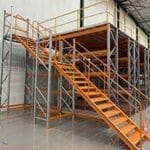A New Wave in Racking Design Standards
Table of contents
The Vertical Leap: Adapting to Height Diversity in Warehouse Racking
Gone are the days of a one-size-fits-all mentality towards racking design. The AS 4084.1:2023 standards acknowledge the diverse needs of warehouses with varying ceiling heights and storage practices. By implementing a sliding scale of height specific force calculations, the new standards offer a nuanced approach that caters to racks up to 3 metres, racks towering over 6 metres, and every size in between.
Racking Up to 3 Metres: The Foundation
For pallet racks up to 3 metres high, a robust force of 0.5 kN is to be applied at any height up to the top of the rack. This recognises the relative stability of lower racking systems and the forces they’re likely to encounter during normal operations, such as manual loading and unloading.
Racking Over 6 Metres: Reaching New Heights
As we scale the heights beyond 6 metres, the force calculation adjusts to a more conservative 0.25 kN applied at the top of the rack. This acknowledges the increased leverage and potential for sway at such elevations, ensuring the design is equipped to handle the unique stresses at these heights.
Racking In-Between: Bridging the Gap
For racks between the 3—to 6-metre range, the standards introduce a game-changing interpolation method. Here, the height specific force calculations are fine-tuned to account for the worst-case scenario at the top of the rack, balanced by considering forces up to 3 metres high. This gradient of force application bridges the gap, ensuring every rack is designed with an eye towards its specific height related challenges.
The Impact of Height-Specific Force Calculations
The implications of this change to include height specific force calculations are far reaching:
- Design Precision: Engineers and designers can now calibrate their racking systems with greater precision, leading to safer and more cost-effective designs.
- Operational Safety: Operators can work with the confidence that their storage systems are built to withstand the specific forces relevant to their operational heights.
- Regulatory Compliance: Warehouses adopting these new standards will meet the latest regulations, avoid potential fines, and increase market competitiveness.
- Preparing for Implementation: To seamlessly integrate these changes, warehouse operations must conduct comprehensive racking audits of their current racking systems and possibly modify or replace them to align with the new standards.
Cutting-Edge Compliance with Rackman
Navigating the complexities of racking design and safety compliance can be daunting. That’s where our Rackman software enters the picture. As a proprietary tool engineered by leading structural engineers, Rackman simplifies the task of ensuring your racking systems meet stringent safety standards. With Rackman software, you receive not just calculations and analyses but also certification, providing peace of mind that your warehouse is secure and compliant.
Secure Your Racking Audit Today
Don’t let the intricacies of the new AS 4084.1:2023 standards leave you perplexed. If all these calculations seem like another language, our Rackman software will decode them for you, ensuring your racking system passes with flying colours. Book a Racking Audit with us to guarantee that your existing racking meets the new standards and secure your operation’s future. Your goods and staff’s safety is paramount—ensure it with Rackman certification.
Conclusion: A Heightened Sense of warehouse racking Safety
The AS 4084.1:2023 standards underscore a pivotal evolution in warehouse safety and design. By capitalising on Colby Rackman software’s advanced capabilities and ensuring your racking systems are audited for compliance, your business will stand on solid ground. Make the leap today for a safer tomorrow.
Next Steps
- Learn More: Read our article on seismic racking standards or download the pallet racking inspection checklist or Vertical Force limits – how strong is you racking
- Get a Quote: for Sydney pallet racking annual inspection or racking audit
- Reach Out: For more information or assistance, contact Total Racking Systems.





